7 Critical Actions Homeowners Must Take After a Burglary
I still remember the first time I came home after a burglary—it’s a feeling you never forget. Your safe space suddenly feels exposed, and every corner of your home seems unfamiliar.
If you’ve just experienced this, I want you to know: you’re not alone, and there are concrete steps you can take right now to regain control.
In this guide, I’ll walk you through seven essential actions every homeowner should follow after a burglary—from ensuring your immediate safety to protecting yourself against future incidents.
My goal isn’t just to tell you what to do but to make sure you feel supported, informed, and empowered every step of the way.
1. Ensure Immediate Safety
The very first thing I tell anyone who’s just experienced a burglary is: leave your home immediately and go somewhere safe. To understand why acting quickly is so important, you can also check out these 11 eye-opening home burglary stats every homeowner needs to know. I know it’s hard—your mind races, and part of you wants to check what’s missing—but your safety is far more important than your belongings. Burglars could still be nearby, and staying inside increases your risk.
Here’s what I usually recommend:
- Go to a neighbor’s house, a trusted friend, or family member. Even a short distance can make a big difference.
- Avoid confronting anyone or trying to chase the burglar. It’s safer to wait for authorities.
- Stay calm and collected. Take deep breaths, and focus on getting somewhere safe before worrying about the property.
2. Contact Law Enforcement Promptly

Once you’re in a safe place, the next step is calling the police immediately. I can’t stress this enough: preserving the scene is crucial. Even the smallest items can provide important clues for investigators.
Here’s what you should do:
- Dial your local emergency number and report the burglary clearly and calmly.
- Avoid touching or moving anything in the house, including doors, windows, or broken items.
- Write down or record everything you remember about the incident while it’s fresh in your mind.
Experts at ADT Security emphasize that preserving the crime scene helps law enforcement collect evidence efficiently, increasing the chances of recovering stolen items and identifying the perpetrators.
3. Document the Incident Thoroughly
Before you start cleaning or repairing anything, document everything in detail. I’ve learned from experience that photographs and written notes are invaluable for both police investigations and insurance claims.
Here’s a practical approach I follow:
- Take clear photos of all damaged areas, including doors, windows, and broken locks.
- Photograph missing items, especially valuables, electronics, or personal documents.
- Create a written inventory of lost or damaged items, including approximate value and description.
- Avoid cleaning up until documentation is complete. Even small changes can affect evidence.
This step may feel tedious, but it protects you legally and financially. Think of it as creating a record that proves exactly what happened, which can save hours of back-and-forth with insurance companies.
4. Notify Your Insurance Provider

Once the police have been contacted and the incident is documented, call your insurance provider right away. In my experience, reporting a burglary within the first 24 hours not only speeds up the claims process but also avoids disputes about delays.
Here’s how I approach it:
- Contact your insurer immediately—ideally within the same day.
- Provide your police report number and a copy if available.
- Share your photo evidence and inventory list so they can start processing the claim without delays.
- Ask about temporary living arrangements if your home is unsecure or damaged.
According to EMC Security, the faster you notify your provider, the faster you can receive compensation for damages and stolen property.
5. Secure Your Property Against Future Incidents
After a burglary, one of the most empowering things you can do is take immediate action to protect your home from another break-in. It’s not just about repairing damage—it’s about regaining your peace of mind.
Here’s what I recommend:
- Replace or reinforce locks on all doors and windows, even if they weren’t damaged.
- Install motion-sensor lights around the property.
- Upgrade to a monitored security system for real-time alerts. If you’re planning to be away from home, make sure to follow these 5 essential steps before going away for the weekend to keep your property secure.
- Consider security cameras to deter future intruders.
Experts at SafeWise note that visible security upgrades—like cameras and alarm signage—dramatically reduce the likelihood of another burglary. For more ideas on smart devices and home security upgrades that can prevent future break-ins, see our guide on 11 smart home tools that keep your house safe from burglars.
6. Manage Financial Risks Promptly
Burglaries aren’t just about physical loss—they can also put your finances and identity at risk. If documents, credit cards, or devices are stolen, you need to act fast to protect yourself from fraud.
Here’s my quick checklist:
- Report stolen cards to your bank or credit card company immediately.
- Contact your check provider to stop payment on any stolen checks.
- Notify credit bureaus to flag your account for potential identity theft.
- Change passwords for online banking, email, and shopping accounts.
Even if you’re not sure something was taken, it’s better to be safe. The sooner you act, the harder it is for criminals to exploit your information.
7. Seek Emotional Support and Counseling

A burglary doesn’t just take your belongings—it can shake your sense of safety to the core. I’ve seen homeowners who, months after the break-in, still struggle to sleep or feel comfortable at home. That’s why I believe addressing the emotional impact is just as important as securing the property.
Here’s what has helped many people I’ve worked with:
- Talk to a licensed counselor or therapist who understands trauma recovery.
- Share your experience with friends or family—don’t isolate yourself.
- Join a local or online support group to connect with people who’ve been through the same thing.
- Practice simple stress-reduction routines like breathing exercises or mindfulness.
Keep a Recovery Timeline
After a burglary, things can feel chaotic. I’ve found that maintaining a clear timeline of all actions taken is one of the best ways to regain control. It helps you stay organized, track progress, and avoid overlooking critical steps.
Here’s how I usually approach it:
- Start immediately: Record the exact date and time of the burglary, and note when the police report was filed.
- Log insurance communication: Keep track of when you contacted your insurance company, claim numbers, and any responses.
- Track repairs and replacements: Document when locks, windows, or other security measures are fixed or upgraded.
- Include follow-ups: Note conversations with banks, credit bureaus, or counseling services.
- Keep everything in one place: Use a dedicated notebook, spreadsheet, or digital document.
A recovery timeline is more than just a checklist—it’s a record that can protect you in case of disputes, reduce stress, and help you feel more in control during a difficult time.
Use Technology to Aid Recovery
Technology can be a lifesaver after a burglary, especially when there are multiple tasks to manage. From tracking stolen items to monitoring insurance claims, the right tools make the recovery process much smoother.
Here’s how I recommend using tech:
- Inventory apps: Use apps to record stolen items with photos and descriptions for insurance purposes.
- Insurance apps: Many insurers have apps that let you submit claims, upload documents, and track progress in real time.
- Security monitoring tools: Smart home cameras, motion sensors, and mobile alerts help you prevent another incident and feel safe.
- Password managers: Secure your online accounts quickly and efficiently if personal devices were stolen.
- Cloud backups: Keep copies of important documents or photos in the cloud for easy access and replacement.
These tools reduce the burden of follow-up tasks, ensure nothing is missed, and give you peace of mind while you focus on emotional recovery.
Regain Control and Rebuild Your Sense of Home
Experiencing a burglary can feel overwhelming, but remember—you can take back control step by step. By following these essential actions—from ensuring immediate safety, contacting law enforcement, and documenting the incident, to securing your property, managing finances, and seeking emotional support—you’re not just responding to the event; you’re rebuilding your sense of safety and confidence.
Keeping a recovery timeline and using modern technology makes the process smoother, giving you clarity and structure when it feels like everything is uncertain. Each step is about protecting yourself, your family, and your home—and slowly restoring peace of mind.
I’d love to hear from you: Have you or someone you know gone through a burglary? What steps helped the most? Share your experience in the comments below—I read and respond to every message.
For more practical, actionable advice on home safety, renovations, and lifestyle improvements, visit Build Like New and explore our latest guides.
Disclaimer: This article is for informational purposes only and does not replace professional legal, medical, or financial advice. Always consult qualified experts for guidance specific to your situation.


